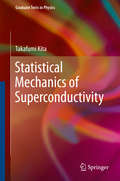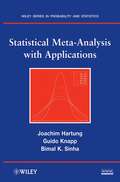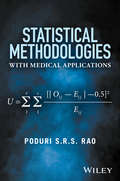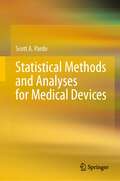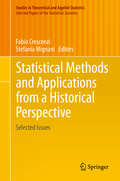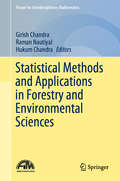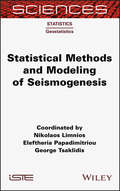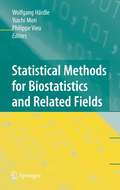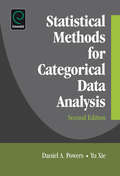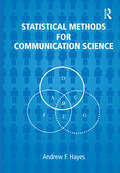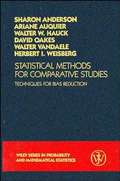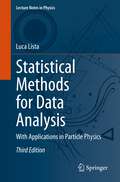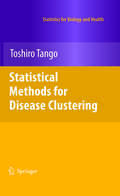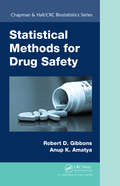- Table View
- List View
Statistical Mechanics of Superconductivity (Graduate Texts in Physics)
by Takafumi KitaThis book provides a theoretical, step-by-step comprehensive explanation of superconductivity for undergraduate and graduate students who have completed elementary courses on thermodynamics and quantum mechanics. To this end, it adopts the unique approach of starting with the statistical mechanics of quantum ideal gases and successively adding and clarifying elements and techniques indispensible for understanding it. They include the spin-statistics theorem, second quantization, density matrices, the Bloch–De Dominicis theorem, the variational principle in statistical mechanics, attractive interaction and bound states. Ample examples of their usage are also provided in terms of topics from advanced statistical mechanics such as two-particle correlations of quantum ideal gases, derivation of the Hartree–Fock equations, and Landau’s Fermi-liquid theory, among others. With these preliminaries, the fundamental mean-field equations of superconductivity are derived with maximum mathematical clarity based on a coherent state in terms of the Cooper-pair creation operator, a quasiparticle field for describing the excitation and the variational principle in statistical mechanics. They have the advantage that the phase coherence due to the Cooper-pair condensation can be clearly seen making the superfluidity comprehensible naturally. Subsequently, they are applied to homogeneous cases to describe the BCS theory for classic s-wave superconductors and its extension to the p-wave superfluidity of 3He. Later, the mean-field equations are simplified to the Eilenberger and Ginzburg–Landau equations so as to describe inhomogeneous superconductivity such as Abrikosov’s flux-line lattice concisely and transparently. Chapters provide the latest studies on the quasiclassical theory of superconductivity and a discovery of p-wave superfluidity in liquid 3He. The book serves as a standard reference for advanced courses of statistical mechanics with exercises along with detailed answers.
Statistical Meta-Analysis with Applications (Wiley Series in Probability and Statistics #738)
by Joachim Hartung Guido Knapp Bimal K. SinhaAn accessible introduction to performing meta-analysis across various areas of research The practice of meta-analysis allows researchers to obtain findings from various studies and compile them to verify and form one overall conclusion. Statistical Meta-Analysis with Applications presents the necessary statistical methodologies that allow readers to tackle the four main stages of meta-analysis: problem formulation, data collection, data evaluation, and data analysis and interpretation. Combining the authors' expertise on the topic with a wealth of up-to-date information, this book successfully introduces the essential statistical practices for making thorough and accurate discoveries across a wide array of diverse fields, such as business, public health, biostatistics, and environmental studies. Two main types of statistical analysis serve as the foundation of the methods and techniques: combining tests of effect size and combining estimates of effect size. Additional topics covered include: Meta-analysis regression procedures Multiple-endpoint and multiple-treatment studies The Bayesian approach to meta-analysis Publication bias Vote counting procedures Methods for combining individual tests and combining individual estimates Using meta-analysis to analyze binary and ordinal categorical data Numerous worked-out examples in each chapter provide the reader with a step-by-step understanding of the presented methods. All exercises can be computed using the R and SAS software packages, which are both available via the book's related Web site. Extensive references are also included, outlining additional sources for further study. Requiring only a working knowledge of statistics, Statistical Meta-Analysis with Applications is a valuable supplement for courses in biostatistics, business, public health, and social research at the upper-undergraduate and graduate levels. It is also an excellent reference for applied statisticians working in industry, academia, and government.
Statistical Meta-Analysis with Applications (Wiley Series in Probability and Statistics #738)
by Joachim Hartung Guido Knapp Bimal K. SinhaAn accessible introduction to performing meta-analysis across various areas of research The practice of meta-analysis allows researchers to obtain findings from various studies and compile them to verify and form one overall conclusion. Statistical Meta-Analysis with Applications presents the necessary statistical methodologies that allow readers to tackle the four main stages of meta-analysis: problem formulation, data collection, data evaluation, and data analysis and interpretation. Combining the authors' expertise on the topic with a wealth of up-to-date information, this book successfully introduces the essential statistical practices for making thorough and accurate discoveries across a wide array of diverse fields, such as business, public health, biostatistics, and environmental studies. Two main types of statistical analysis serve as the foundation of the methods and techniques: combining tests of effect size and combining estimates of effect size. Additional topics covered include: Meta-analysis regression procedures Multiple-endpoint and multiple-treatment studies The Bayesian approach to meta-analysis Publication bias Vote counting procedures Methods for combining individual tests and combining individual estimates Using meta-analysis to analyze binary and ordinal categorical data Numerous worked-out examples in each chapter provide the reader with a step-by-step understanding of the presented methods. All exercises can be computed using the R and SAS software packages, which are both available via the book's related Web site. Extensive references are also included, outlining additional sources for further study. Requiring only a working knowledge of statistics, Statistical Meta-Analysis with Applications is a valuable supplement for courses in biostatistics, business, public health, and social research at the upper-undergraduate and graduate levels. It is also an excellent reference for applied statisticians working in industry, academia, and government.
Statistical Methodologies with Medical Applications
by Poduri S.R.S. RaoThis book presents the methodology and applications of a range of important topics in statistics, and is designed for graduate students in Statistics and Biostatistics and for medical researchers. Illustrations and more than ninety exercises with solutions are presented. They are constructed from the research findings of the medical journals, summary reports of the Centre for Disease Control (CDC) and the World Health Organization (WHO), and practical situations. The illustrations and exercises are related to topics such as immunization, obesity, hypertension, lipid levels, diet and exercise, harmful effects of smoking and air pollution, and the benefits of gluten free diet. This book can be recommended for a one or two semester graduate level course for students studying Statistics, Biostatistics, Epidemiology and Health Sciences. It will also be useful as a companion for medical researchers and research oriented physicians.
Statistical Methodologies with Medical Applications
by Poduri S.R.S. RaoThis book presents the methodology and applications of a range of important topics in statistics, and is designed for graduate students in Statistics and Biostatistics and for medical researchers. Illustrations and more than ninety exercises with solutions are presented. They are constructed from the research findings of the medical journals, summary reports of the Centre for Disease Control (CDC) and the World Health Organization (WHO), and practical situations. The illustrations and exercises are related to topics such as immunization, obesity, hypertension, lipid levels, diet and exercise, harmful effects of smoking and air pollution, and the benefits of gluten free diet. This book can be recommended for a one or two semester graduate level course for students studying Statistics, Biostatistics, Epidemiology and Health Sciences. It will also be useful as a companion for medical researchers and research oriented physicians.
Statistical Methods: A Geometric Primer
by David J. Saville Graham R. WoodThe aim of this book is to present the mathematics underlying elementary statistical methods in as simple a manner as possible. These methods include independent and paired sample t-tests, analysis of variance, regression, and the analysis of covariance. The author's principle tool is the use of geometric ideas to provide more visual insight and to make the theory accessible to a wider audience than is usually possible.
Statistical Methods and Analyses for Medical Devices
by Scott A. PardoThis book provides a reference for people working in the design, development, and manufacturing of medical devices. While there are no statistical methods specifically intended for medical devices, there are methods that are commonly applied to various problems in the design, manufacturing, and quality control of medical devices. The aim of this book is not to turn everyone working in the medical device industries into mathematical statisticians; rather, the goal is to provide some help in thinking statistically, and knowing where to go to answer some fundamental questions, such as justifying a method used to qualify/validate equipment, or what information is necessary to support the choice of sample sizes.While, there are no statistical methods specifically designed for analysis of medical device data, there are some methods that seem to appear regularly in relation to medical devices. For example, the assessment of receiver operating characteristic curves is fundamental to development of diagnostic tests, and accelerated life testing is often critical for assessing the shelf life of medical device products. Another example is sensitivity/specificity computations are necessary for in-vitro diagnostics, and Taguchi methods can be very useful for designing devices. Even notions of equivalence and noninferiority have different interpretations in the medical device field compared to pharmacokinetics. It contains topics such as dynamic modeling, machine learning methods, equivalence testing, and experimental design, for example.This book is for those with no statistical experience, as well as those with statistical knowledgeable—with the hope to provide some insight into what methods are likely to help provide rationale for choices relating to data gathering and analysis activities for medical devices.
Statistical Methods and Applications from a Historical Perspective: Selected Issues (Studies in Theoretical and Applied Statistics)
by Fabio Crescenzi Stefania MignaniThe book showcases a selection of peer-reviewed papers, the preliminary versions of which were presented at a conference held 11-13 June 2011 in Bologna and organized jointly by the Italian Statistical Society (SIS), the Institute national Institute of Statistics (ISTAT) and the Bank of Italy. The theme of the conference was "Statistics in the 150 years of the Unification of Italy." The celebration of the anniversary of Italian unification provided the opportunity to examine and discuss the methodological aspects and applications from a historical perspective and both from a national and international point of view. The critical discussion on the issues of the past has made it possible to focus on recent advances, considering the studies of socio-economic and demographic changes in European countries.
Statistical Methods and Applications in Forestry and Environmental Sciences (Forum for Interdisciplinary Mathematics)
by Girish Chandra Raman Nautiyal Hukum ChandraThis book presents recent developments in statistical methodologies with particular relevance to applications in forestry and environmental sciences. It discusses important methodologies like ranked set sampling, adaptive cluster sampling, small area estimation, calibration approach-based estimators, design of experiments, multivariate techniques, Internet of Things, and ridge regression methods. It also covers the history of the implementation of statistical techniques in Indian forestry and the National Forest Inventory of India.The book is a valuable resource for applied statisticians, students, researchers, and practitioners in the forestry and environment sector. It includes real-world examples and case studies to help readers apply the techniques discussed. It also motivates academicians and researchers to use new technologies in the areas of forestry and environmental sciences with the help of software like R, MATLAB, Statistica, and Mathematica.
Statistical Methods and Applications in Insurance and Finance: CIMPA School, Marrakech and Kelaat M’gouna, Morocco, April 2013 (Springer Proceedings in Mathematics & Statistics #158)
by M’hamed Eddahbi El Hassan Essaky Josep VivesThis book is the outcome of the CIMPA School on Statistical Methods and Applications in Insurance and Finance, held in Marrakech and Kelaat M'gouna (Morocco) in April 2013. It presents two lectures and seven refereed papers from the school, offering the reader important insights into key topics. The first of the lectures, by Frederic Viens, addresses risk management via hedging in discrete and continuous time, while the second, by Boualem Djehiche, reviews statistical estimation methods applied to life and disability insurance. The refereed papers offer diverse perspectives and extensive discussions on subjects including optimal control, financial modeling using stochastic differential equations, pricing and hedging of financial derivatives, and sensitivity analysis. Each chapter of the volume includes a comprehensive bibliography to promote further research.
Statistical Methods and Modeling of Seismogenesis
by Nikolaos Limnios Eleftheria Papadimitriou George TsaklidisThe study of earthquakes is a multidisciplinary field, an amalgam of geodynamics, mathematics, engineering and more. The overriding commonality between them all is the presence of natural randomness. Stochastic studies (probability, stochastic processes and statistics) can be of different types, for example, the black box approach (one state), the white box approach (multi-state), the simulation of different aspects, and so on. This book has the advantage of bringing together a group of international authors, known for their earthquake-specific approaches, to cover a wide array of these myriad aspects. A variety of topics are presented, including statistical nonparametric and parametric methods, a multi-state system approach, earthquake simulators, post-seismic activity models, time series Markov models with regression, scaling properties and multifractal approaches, selfcorrecting models, the linked stress release model, Markovian arrival models, Poisson-based detection techniques, change point detection techniques on seismicity models, and, finally, semi-Markov models for earthquake forecasting.
Statistical Methods and Modeling of Seismogenesis
by Nikolaos Limnios Eleftheria Papadimitriou George TsaklidisThe study of earthquakes is a multidisciplinary field, an amalgam of geodynamics, mathematics, engineering and more. The overriding commonality between them all is the presence of natural randomness. Stochastic studies (probability, stochastic processes and statistics) can be of different types, for example, the black box approach (one state), the white box approach (multi-state), the simulation of different aspects, and so on. This book has the advantage of bringing together a group of international authors, known for their earthquake-specific approaches, to cover a wide array of these myriad aspects. A variety of topics are presented, including statistical nonparametric and parametric methods, a multi-state system approach, earthquake simulators, post-seismic activity models, time series Markov models with regression, scaling properties and multifractal approaches, selfcorrecting models, the linked stress release model, Markovian arrival models, Poisson-based detection techniques, change point detection techniques on seismicity models, and, finally, semi-Markov models for earthquake forecasting.
Statistical Methods: Connections, Equivalencies, and Relationships
by Kenneth J. Berry Janis E. JohnstonThe primary purpose of this book is to introduce the reader to a wide variety of interesting and useful connections, relationships, and equivalencies between and among conventional and permutation statistical methods. There are approximately 320 statistical connections and relationships described in this book. For each connection or connections the tests are described, the connection is explained, and an example analysis illustrates both the tests and the connection(s). The emphasis is more on demonstrations than on proofs, so little mathematical expertise is assumed. While the book is intended as a stand-alone monograph, it can also be used as a supplement to a standard textbook such as might be used in a second- or third-term course in conventional statistical methods. Students, faculty, and researchers in the social, natural, or hard sciences will find an interesting collection of statistical connections and relationships - some well-known, some more obscure, and some presented here for the first time.
Statistical Methods for Astronomical Data Analysis (Springer Series in Astrostatistics #3)
by Asis Kumar Chattopadhyay Tanuka ChattopadhyayThis book introduces “Astrostatistics” as a subject in its own right with rewarding examples, including work by the authors with galaxy and Gamma Ray Burst data to engage the reader. This includes a comprehensive blending of Astrophysics and Statistics. The first chapter’s coverage of preliminary concepts and terminologies for astronomical phenomenon will appeal to both Statistics and Astrophysics readers as helpful context. Statistics concepts covered in the book provide a methodological framework. A unique feature is the inclusion of different possible sources of astronomical data, as well as software packages for converting the raw data into appropriate forms for data analysis. Readers can then use the appropriate statistical packages for their particular data analysis needs. The ideas of statistical inference discussed in the book help readers determine how to apply statistical tests. The authors cover different applications of statistical techniques already developed or specifically introduced for astronomical problems, including regression techniques, along with their usefulness for data set problems related to size and dimension. Analysis of missing data is an important part of the book because of its significance for work with astronomical data. Both existing and new techniques related to dimension reduction and clustering are illustrated through examples. There is detailed coverage of applications useful for classification, discrimination, data mining and time series analysis. Later chapters explain simulation techniques useful for the development of physical models where it is difficult or impossible to collect data. Finally, coverage of the many R programs for techniques discussed makes this book a fantastic practical reference. Readers may apply what they learn directly to their data sets in addition to the data sets included by the authors.
Statistical Methods for Biostatistics and Related Fields
by Wolfgang Härdle Yuichi Mori Philippe VieuThis book covers a wide range of recent statistical methods that are of interest to scientists in biostatistics as well as in other related fields such as chemometrics, environmetrics and geophysics. The contributed papers, from internationally recognized researchers, present various statistical methodologies together with a selected scope of their main mathematical properties and their application in a real case study.
Statistical Methods for Categorical Data Analysis
by Daniel Powers Yu XieThis book provides a comprehensive introduction to methods and models for categorical data analysis and their applications in social science research. An explicit aim of the book is to integrate the transformational and the latent variable approach, two diverse but complementary traditions dealing with the analysis of categorical data. This is the first introductory text to cover models and methods for discrete dependent variables, cross-classifications, and longitudinal data in a rigorous, yet accessible, manner in a single volume.The second edition of this book includes new material on multilevel models for categorical data. Several chapters have undergone extensive revisions and extensions to include new applications and examples. Highlights of the 2nd edition include a detailed discussion of classical and Bayesian estimation techniques for hierarchical/multilevel models, extensive coverage of discrete-time hazard models and Cox regression models, and methods for evaluating and accommodating departures from model assumptions. The accompanying website contains programming scripts to replicate each example using various statistical packages, which has proven to be an invaluable resource for instructors, students, and researchers. This book presents the essential methods and models that form the core of contemporary social statistics. The book covers a remarkable range of models that have applications in sociology, demography, psychometrics, econometrics, political science, biostatistics, and other fields. It will be especially useful as a graduate textbook for students in advanced social statistics courses and as a reference book for applied researchers. Companion website also available, at https://webspace.utexas.edu/dpowers/www/
Statistical Methods for Communication Science (Routledge Communication Series)
by Andrew F. HayesStatistical Methods for Communication Science is the only statistical methods volume currently available that focuses exclusively on statistics in communication research. Writing in a straightforward, personal style, author Andrew F. Hayes offers this accessible and thorough introduction to statistical methods, starting with the fundamentals of measurement and moving on to discuss such key topics as sampling procedures, probability, reliability, hypothesis testing, simple correlation and regression, and analyses of variance and covariance. Hayes takes readers through each topic with clear explanations and illustrations. He provides a multitude of examples, all set in the context of communication research, thus engaging readers directly and helping them to see the relevance and importance of statistics to the field of communication.Highlights of this text include:*thorough and balanced coverage of topics;*integration of classical methods with modern "resampling" approaches to inference;*consideration of practical, "real world" issues;*numerous examples and applications, all drawn from communication research;*up-to-date information, with examples justifying use of various techniques; and*a CD with macros, data sets, figures, and additional materials.This unique book can be used as a stand-alone classroom text, a supplement to traditional research methods texts, or a useful reference manual. It will be invaluable to students, faculty, researchers, and practitioners in communication, and it will serve to advance the understanding and use of statistical methods throughout the discipline.
Statistical Methods for Communication Science (Routledge Communication Series)
by Andrew F. HayesStatistical Methods for Communication Science is the only statistical methods volume currently available that focuses exclusively on statistics in communication research. Writing in a straightforward, personal style, author Andrew F. Hayes offers this accessible and thorough introduction to statistical methods, starting with the fundamentals of measurement and moving on to discuss such key topics as sampling procedures, probability, reliability, hypothesis testing, simple correlation and regression, and analyses of variance and covariance. Hayes takes readers through each topic with clear explanations and illustrations. He provides a multitude of examples, all set in the context of communication research, thus engaging readers directly and helping them to see the relevance and importance of statistics to the field of communication.Highlights of this text include:*thorough and balanced coverage of topics;*integration of classical methods with modern "resampling" approaches to inference;*consideration of practical, "real world" issues;*numerous examples and applications, all drawn from communication research;*up-to-date information, with examples justifying use of various techniques; and*a CD with macros, data sets, figures, and additional materials.This unique book can be used as a stand-alone classroom text, a supplement to traditional research methods texts, or a useful reference manual. It will be invaluable to students, faculty, researchers, and practitioners in communication, and it will serve to advance the understanding and use of statistical methods throughout the discipline.
Statistical Methods for Comparative Studies: Techniques for Bias Reduction (Wiley Series in Probability and Statistics #170)
by Sharon Roe Anderson Ariane Auquier Walter W. Hauck David Oakes Walter Vandaele Dr. Herbert I. WeisbergBrings together techniques for the design and analysis of comparative studies. Methods include multivariate matching, standardization and stratification, analysis of covariance, logit analysis, and log linear analysis. Quantitatively assesses techniques' effectiveness in reducing bias. Discusses hypothesis testing, survival analysis, repeated measure design, and causal inference from comparative studies.
Statistical Methods for Data Analysis: With Applications in Particle Physics (Lecture Notes in Physics #1010)
by Luca ListaThis third edition expands on the original material. Large portions of the text have been reviewed and clarified. More emphasis is devoted to machine learning including more modern concepts and examples. This book provides the reader with the main concepts and tools needed to perform statistical analyses of experimental data, in particular in the field of high-energy physics (HEP).It starts with an introduction to probability theory and basic statistics, mainly intended as a refresher from readers’ advanced undergraduate studies, but also to help them clearly distinguish between the Frequentist and Bayesian approaches and interpretations in subsequent applications. Following, the author discusses Monte Carlo methods with emphasis on techniques like Markov Chain Monte Carlo, and the combination of measurements, introducing the best linear unbiased estimator. More advanced concepts and applications are gradually presented, including unfolding and regularization procedures, culminating in the chapter devoted to discoveries and upper limits.The reader learns through many applications in HEP where the hypothesis testing plays a major role and calculations of look-elsewhere effect are also presented. Many worked-out examples help newcomers to the field and graduate students alike understand the pitfalls involved in applying theoretical concepts to actual data.
Statistical Methods for Data Analysis in Particle Physics (Lecture Notes in Physics #941)
by Luca ListaThis concise set of course-based notes provides the reader with the main concepts and tools needed to perform statistical analyses of experimental data, in particular in the field of high-energy physics (HEP). First, the book provides an introduction to probability theory and basic statistics, mainly intended as a refresher from readers’ advanced undergraduate studies, but also to help them clearly distinguish between the Frequentist and Bayesian approaches and interpretations in subsequent applications. More advanced concepts and applications are gradually introduced, culminating in the chapter on both discoveries and upper limits, as many applications in HEP concern hypothesis testing, where the main goal is often to provide better and better limits so as to eventually be able to distinguish between competing hypotheses, or to rule out some of them altogether.Many worked-out examples will help newcomers to the field and graduate students alike understand the pitfalls involved in applying theoretical concepts to actual data. This new second edition significantly expands on the original material, with more background content (e.g. the Markov Chain Monte Carlo method, best linear unbiased estimator), applications (unfolding and regularization procedures, control regions and simultaneous fits, machine learning concepts) and examples (e.g. look-elsewhere effect calculation).
Statistical Methods for Data Analysis in Particle Physics (Lecture Notes in Physics #909)
by Luca ListaThis concise set of course-based notes provides the reader with the main concepts and tools to perform statistical analysis of experimental data, in particular in the field of high-energy physics (HEP). First, an introduction to probability theory and basic statistics is given, mainly as reminder from advanced undergraduate studies, yet also in view to clearly distinguish the Frequentist versus Bayesian approaches and interpretations in subsequent applications. More advanced concepts and applications are gradually introduced, culminating in the chapter on upper limits as many applications in HEP concern hypothesis testing, where often the main goal is to provide better and better limits so as to be able to distinguish eventually between competing hypotheses or to rule out some of them altogether. Many worked examples will help newcomers to the field and graduate students to understand the pitfalls in applying theoretical concepts to actual data.
Statistical Methods for Disease Clustering (Statistics for Biology and Health)
by Toshiro TangoThis book is intended to provide a text on statistical methods for detecting clus ters and/or clustering of health events that is of interest to ?nal year undergraduate and graduate level statistics, biostatistics, epidemiology, and geography students but will also be of relevance to public health practitioners, statisticians, biostatisticians, epidemiologists, medical geographers, human geographers, environmental scien tists, and ecologists. Prerequisites are introductory biostatistics and epidemiology courses. With increasing public health concerns about environmental risks, the need for sophisticated methods for analyzing spatial health events is immediate. Further more, the research area of statistical tests for disease clustering now attracts a wide audience due to the perceived need to implement wide ranging monitoring systems to detect possible health related bioterrorism activity. With this background and the development of the geographical information system (GIS), the analysis of disease clustering of health events has seen considerable development over the last decade. Therefore, several excellent books on spatial epidemiology and statistics have re cently been published. However, it seems to me that there is no other book solely focusing on statistical methods for disease clustering. I hope that readers will ?nd this book useful and interesting as an introduction to the subject.
Statistical Methods for Drug Safety
by Robert D. Gibbons Anup AmatyaExplore Important Tools for High-Quality Work in Pharmaceutical SafetyStatistical Methods for Drug Safety presents a wide variety of statistical approaches for analyzing pharmacoepidemiologic data. It covers both commonly used techniques, such as proportional reporting ratios for the analysis of spontaneous adverse event reports, and newer approach
Statistical Methods for Dynamic Disease Screening and Spatio-Temporal Disease Surveillance (Chapman & Hall/CRC Biostatistics Series)
by Peihua QiuDisease screening and disease surveillance (DSDS) constitute two critical areas in public health, each presenting distinctive challenges primarily due to their sequential decision-making nature and complex data structures. Statistical Methods for Dynamic Disease Screening and Spatio-Temporal Disease Surveillance explores numerous recent analytic methodologies that enhance traditional techniques. The author, a prominent researcher specializing in innovative sequential decision-making techniques, demonstrates how these novel methods effectively address the challenges of DSDS.After a concise introduction that lays the groundwork for comprehending the challenges inherent in DSDS, the book delves into fundamental statistical concepts and methods relevant to DSDS. This includes exploration of statistical process control (SPC) charts specifically crafted for sequential decision-making purposes. The subsequent chapters systematically outline recent advancements in dynamic screening system (DySS) methods, fine-tuned for effective disease screening. Additionally, the text covers both traditional and contemporary analytic methods for disease surveillance. It further introduces two recently developed R packages designed for implementing DySS methods and spatio-temporal disease surveillance techniques pioneered by the author's research team.Features• Presents Recent Analytic Methods for DSDS: The book introduces analytic methods for DSDS based on SPC charts. These methods effectively utilize all historical data, accommodating the complex data structure inherent in sequential decision-making processes.• Introduces Recent R Packages: Two recent R packages, DySS and SpTe2M, are introduced. The book not only presents these packages but also demonstrates key DSDS methods using them.• Examines Recent Research Results: The text delves into the latest research findings across various domains, including dynamic disease screening, nonparametric spatio-temporal data modeling and monitoring, and spatio-temporal disease surveillance.• Accessible Description of Methods: Major methods are described in a manner accessible to individuals without advanced knowledge in mathematics and statistics. The goal is to facilitate a clear understanding of ideas and easy implementation.• Real-Data Examples: To aid comprehension, the book provides several real-data examples illustrating key concepts and methods.• Hands-on Exercises: Each chapter includes exercises to encourage hands-on practice, allowing readers to engage directly with the presented methods.
